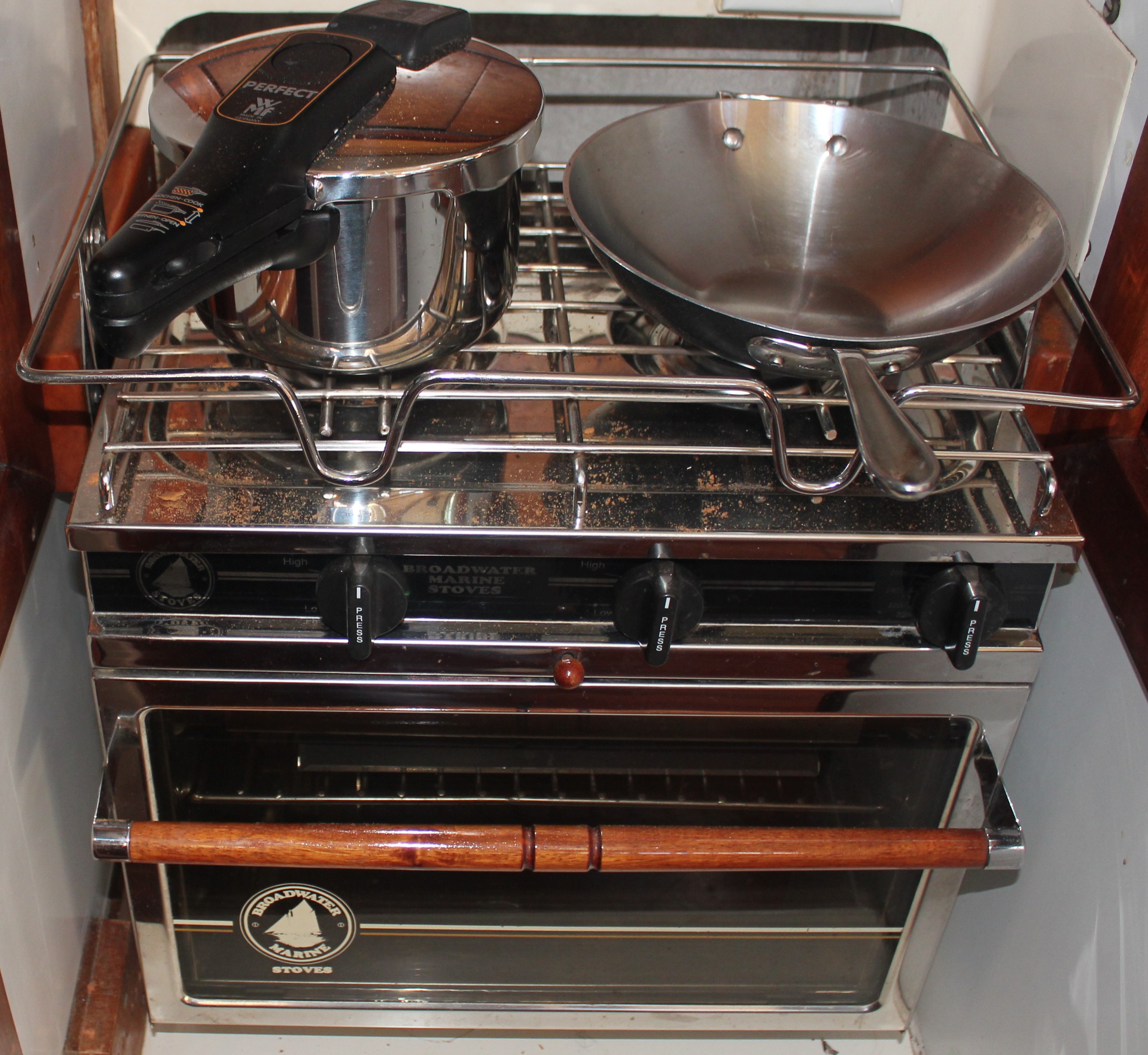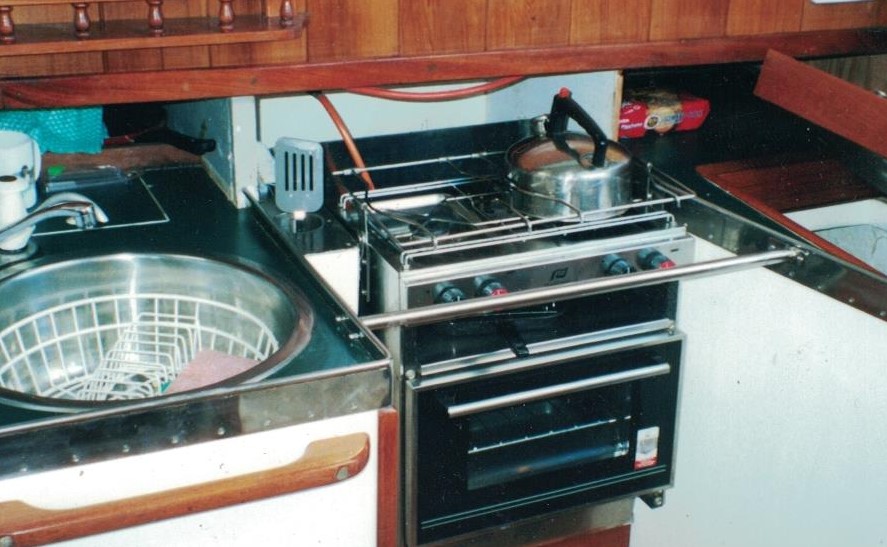Cooking on a Boat
Cooking on a boat presents many problems, and this is encountered whether in a marina, swinging on the anchor or on a mooring, or sailing under way on passage. Most yachts and boats it must be said, travel on their stomachs. When the cook or food goes bad so does most other things that include morale and even relationships. So even if you are a liveaboard in the marina or sailing to exotic and warm tropical places, the challenges will confront you.
The first major problem is the space restrictions on the average boat. Galleys are by default, relatively small and cramped. Unless you are fortunate to be taking delivery of a sizeable new vessel, then you might have that dream galley, but if you are like the rest us mere mortals, you will have to make do with what is installed on your boat of choice. A small galley must be well organized. with everything in its place, and everything required to cook a meal easily located to hand. Galley ergonomics is an important consideration that is often not considered very well at a boat design stage. Also coupled with this are the all important provision stowage, as how to store and maintain food quality is a key factor. Also related to this is the subject of potable water quality and quantity, and also refrigeration of perishable foods. Then there is the even more challenging issues of ventilation along with stove and cooker fuels. The most critical factor above all of these is how to maintain safety in the galley. Galley safety is essential and it is so easy to have an accident that puts you and your crew at risk. Follow and observe these safety messages and manage your cooking so as to avoid them.
Cooking on a Boat - Maintaining
Balance
The second problem is that of movement. Movement directly impacts on galley safety. The constant movement besides being largely resultant on the prevailing sea conditions, is also very much to do with the sea kindliness of particular vessels. A light weight racer cruiser may be very tender and bounce around, while a heavy displacement vessel will be more stable and sea kindly. Of course a boat will move around in a marina as well, as the wash of passing craft create movement, as do windy days as the gusts heel the boat over.
Maintaining balance with the continuous gyrating three-dimensional movement of a boat is a challenge and a major source of difficulties. It is not easy being a one-armed cook. Shoulder injuries are common and rotator cuff injuries that occur when one tries to stop a fall is a common cause, both up on deck and down below. Handling sharp knives is a risk when moving, it is easy to slice a finger when prepping food so consider how to do so safely. Galley design plays a big part in any activity and most of us get stuck with the design whether it be U shaped or L shaped.
- Galley Straps. Install a galley strap or "buttstrap" so that you can lean back into it and leave both hands free to cook. They are of adjustable polyester webbing construction with snap hooks at each end. Westmarine stock them and in the UK Jimmy Green has them. Some say they create risks in front of the stove and increase the risk of burns and scalds, others do not, so it is a case of experimenting with what works best for you.
- Grab Bars. The cooker should have a strong bar mounted in front of the cooker to grab onto. This is an easy item to install and look at other locations where a hand hold can be installed. The image shows same installed on a previous boat of mine.
Cooker Stability
The more weight you put on a cooker the more unstable it becomes, and regrettably many cookers are not properly balanced. On most cookers, you open the oven door and the oven tilts considerably. This is unfortunate as you cannot remove a baking tray or whatever onto the door to rest with risking serious injury. This stability problem also has implications when cooking at sea with a heavy pot or two on the top. My own solution on my previous boats was to secure some lead to the bottom, in fact a few divers weights. You will need to experiment with this.
- Cooker Risk Assessment. Check how your cooker behaves when fully loaded. Fill a kettle with water, and fill a large pot with water to simulate maximum loading. See how well balanced the cooker is on the gimbals.
- Cooker Installation. Ensure that the cooker has properly installed fiddle rails and pot clamps to hold everything in place, in addition to gimballing. There are still many who do not have them.
Cooking on a Boat - Resources
The third problem is that of limited resources, you can only carry and stow so much. It must be remembered that passage making and rolling anchorages probably represent only 25% or less of cruising, so in most cases the biggest challenges arise from resources and where to find them. This in particular impacts on nutrition, and the cruising budget. Without a local supermarket or favorite deli close by, cruising food requires a significant amount of long-term planning, and alteration to eating habits. Even in a marina suitable markets may require transport which impacts the cruising kitty. Storing up in foreign places generally means that the original provisioning list is unlikely to be available, and it becomes an exercise in adaptation, improvisation and some culinary experimentation. If you want to maintain your home-based diets and favorite foods, then you may have to pay quite a premium to do so.
Nutrition requirements vary when cruising, and it is easy to fall into a snacking or grazing habit when feeding. Energy expenditure is often under rated when cruising and when the weather blows up and the energy levels fade, the results of inadequate feeding will soon show up. Nutrition is a little like feeding a star athlete when sailing, lots of energy foods and well balanced in terms of nutrition.
An important consideration are the variations in peoples individual and special diet requirements. Many people have food intolerances such as gluten and allergies that include nuts and seafood, or restrictions based on religious and cultural heritage. Some have diets based on choice such as vegan, vegetarian, paleo and so on. That doesn’t include the fact some people just do not like certain foods and you have to factor that into your planning. Cooking on a boat can be a challenge but also an adventure and a voyage of culinary discovery. Cooking on a boat can be challenging but worth the effort.

